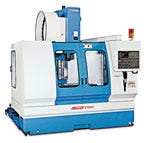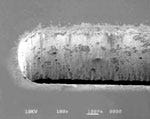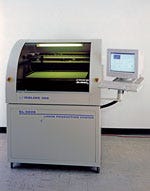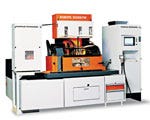Machining Equipment Suppliers Focus on Production Efficiency
July 6, 2001
Originally Published MPMN July/August 2001
EQUIPMENT NEWS: Machining Equipment
Machining Equipment Suppliers Focus on Production Efficiency
Machines offer quick changeover and precise cutting of a variety of materials
Used in a range of operations from prototyping to metal finishing, machining equipment is an integral part of the manufacturing process. To provide cost-effective solutions to manufacturers, equipment suppliers have developed machines that increase productivity and speed while maintaining quality levels. Following is a sampling of machining equipment suitable for medical device manufacturing.
|
YCI Supermax's FV105A has a powerful spindle for high-production applications. |
A midsize vertical machining center that attains speeds of 20,000 rpm and has a 30-hp spindle can perform rough cutting and finished cutting from the same spindle. Supplied by YCI Supermax, the FV105A's rapid cutting and feeding rates, combined with its powerful spindle, allow cutting of a range of materials from aluminum to titanium. In addition, the center's speed and versatility result in very short cycle times. The x- and y-axes incorporate THK NR linear guide ways, while the z-axis features hardened and ground box ways. Standard features include oil and air-mist spindle bearing lubrication, an alphanumeric keyboard, a spindle and cutting air blast system, full chips and coolant guards, and a swivel control panel for easy operation. The center has a 40 x 20 x 24-in work envelope and a wide saddle and machine base. The center is made from Meehanite casting and has a rigid body construction. Preloaded ball screws are coupled to the servomotors for increased reliability.
Like the FV105A, the FV102A is a vertical machining center made from Meehanite casting and also includes ball screws attached to servomotors. Both systems have a 24-tool swing arm ATC system that optimizes production flow and efficiency, features a bidirectional random access tool magazine, and provides ±0.00016-in. accuracy with ±0.00008-in. repeatability. The FV102A's unique feature is an automatic pallet changer (APC). The APC utilizes a high-speed servo-driven mechanism that completes a cycle in 12 seconds, reducing machine idle time and increasing productivity. The operator is able to load, unload, inspect parts, and set up jobs while an alternate pallet is in the machine.
Surface grinder is suitable for fragile, thermosensitive materials
A precision surface grinder can machine hard materials such as tungsten carbide, cobalt-chrome, titanium, and stainless steel, and provides cool, burr-free grinding on many conductive materials. The Model EG618 from Everite Machine Products produces low cutting forces, which allow deep cuts to be achieved on thin, fragile materials without a heat-affected zone, a recast layer, or metallurgical damage to the workpiece. Accessories include a fully enclosed splash guard, a nickel-plated cast-iron table, vertical and cross-feed handwheels, and an automatic one-shot way-lube system. A digital readout and a table drive system are some of the available options. The electrolytic grinding spindle has integral brush rigging, a 300–1000-A capacity, and wheel guards and wheel adapters measuring up to 10 in. diam and 7 in. wide. The electrolyte supply system includes a pump, tank, filtration system, and mist collector, as well as a variety of nozzles for optimum electrolyte flow. Tubing and cannulae, arthroscopic and laproscopic instruments, and implant devices are among the components that can be machined using this system.
Short-wavelength lasers provide high-resolution features
|
A 0.675-mm-thick silicon wafer was machined by the PowerGator 532-15, supplied by Lambda Physik. |
An industrial-grade diode-pumped solid-state laser delivers more than 13.5 W average power and up to 50 GW/sq cm peak-power intensity. Available from Lambda Physik, the PowerGator 532-15 microfabricates high-aspect-ratio features in hard materials that are more than 1 mm thick. Short 15-nanosecond pulses and green 532-nm wavelengths improve plasma penetration and reduce heat-induced effects, microcracking, and redeposition of material. These features yield higher quality surfaces than longer-pulse green, UV, and IR systems, according to the firm, and the unit's beam quality allows processing of feature sizes smaller than 20 µm. The PowerGator 532-15 has an MTBF rating of between 10,000 and 20,000 hours, and it is suited for processing ceramics, silicon, and metal alloys.
Photomachining Inc.'s roll-to-roll laser tool is also suitable for thermal-free cutting and scoring of plastics, metals, ceramics, and other materials. A frequency tripled Nd:YAG laser is used to pattern gold film and to completely cut though several plastic substrates. The laser emits photons at a 355-nm wavelength, in the ultraviolet portion of the spectrum. Short pulse lengths allow clean material removal and produce high-resolution features. The laser can be pulsed at a 100-kHz repetition rate and the beam can be delivered through a galvanometer-based system. The roll-to-roll system enables beam rastering at high speeds over a 12-in. scanfield with a <40-µm spot on target. Indium tin oxide, metal films, and other films can be removed to create simple or complex patterns that are easily generated on AutoCAD and directly downloaded to the laser tool in DXF or DXG formats. The system's reliability and low operating costs makes it suited for the production of disposable medical parts.
Self-contained systems offer hands-off machining
Designed to machine small parts at high speeds, a precision machining center has a 1 x 1.5-m footprint. Mikron Bostomatic's Model 12 can be equipped with a compact robotic part and tool loader for unmanned machining. The robot can feed as many as 48 cutters and 90 workpieces and can be configured to support EROWA, System 3R, and Mecatool tooling. A 30,000-rpm spindle increases roughing capability. The model has a 13 x 10 x 10-in. working cube and can precisely machine graphite, copper, and steel. Capable of 600 in./min 3-D contouring feed rates and 1-G accelerations, the Model 12 provides ±0.000075-in. accuracy and comes with 0.5-µm glass scales. Options include a sealed dust-removal system for graphite machining, mist lubrication for metal cutting and automatic tool measurement probing, a compact fourth axis, and a laser tool-setting system. Typical applications include production of graphite or copper electrodes, engraving, hard-die milling, and small medical component machining. The company's motion control technology ensures path accuracy for tight tolerances at high feed rates. New CNC features include fast microprocessors and software, large hard drives, a new flat-panel display, 3-D cutter compensation, advanced tool measurement, and a remote alert system.
|
A self-contained system, the SL-3020 from Online Inc. is suited for R&D labs or production use. |
A self-contained laser system has the capability to mark and cut hundreds of different materials. The SL-3020 from Online Inc. has a 30 x 20 x 12-in. work area. An autofocus feature sets the laser beam focus to the substrate by the click of a button. The workpiece remains stationary while the laser beam moves overhead on a high-speed gantry system. The controls operate in a Windows 98 environment with familiar point-and-click operation. The noncontact method allows thin, delicate parts to be cut at speeds up to 80 in./sec without drag or tearing. System features include the ability to import more than 40 file formats and to control external inputs and outputs for streamlined, high-volume production applications. Serializing and bar coding are offered for product identification. CAD/CAM operation is possible through DXF file converting. A brushless ac servomotor provides high-resolution closed-loop feedback. The hardened rail and ball-bearing slide design does not require recirculating bearings that can transmit noise and vibration. The SL-3020's strong box construction allows integration of conveyors for pass-through applications. The center is suited for R&D labs as well as manufacturing production floors.
Laser system performs rapid prototyping of microfluidic devices
|
Potomac Photonics' laser system cuts and drills polyamides and similar materials. |
A vertical laser micromachining center is suitable for manufacturing microfluidic channels in polyamides, polycarbonates, Mylar, acrylics, and similar materials. Based on Potomac Photonics' LMT-4500 laser, this machine features beam-shaping methods to prevent material buildup, turbulence generation caused by uneven channel floors, profile deviations, and channel widening at microchannel intersections. Another benefit of the machine is its ability to add microvias at desired locations within the channel structure. A programmable aperture increases production flexibility and eliminates the need to generate a mask. Product designs can be downloaded from a CAD file to the micromachining center, making the unit appropriate for rapid prototyping applications. The Waveguide excimer laser features a 248-nm wavelength, up to 0.45-mJ pulse energy, a 1.5-kHz repetition rate, and 0.45-W average power. The center has a 34 x 34-in. footprint.
EDM accessories allow automatic changeovers
|
Charmilles Technologies' Robofil 2030SI-TW integrates an automated dual-wire system. |
A stand-alone robot provides speed, flexibility, and productivity for users of EDMs. Provided by Charmilles Technologies, the Roboform 35 QCRi allows users to realize up to 6000 hours of uninterrupted machining per year. Designed to handle magazine loading during machining, the robot reduces changeover times and allows machines to run on nights and weekends to make EDMs more productive. A magazine rack that stores electrodes and workpieces can be configured in three different ways and can hold up to 90 electrodes and up to 8 pallets. The robot can manipulate electrodes weighing up to 44 lb and pallets weighing up to 88 lb. An autorestart feature allows the robot to resume machining operations in the event of a tool changeover during a power failure. A dual gripper system integrated into the robot arm reduces changeover time from pallets to electrodes; the robot's transfer arm moves simultaneously in all four axes to minimize cycle times. Dielectric levels are adjusted automatically by the standard drop tank design, allowing various workpiece heights to be machined without manual intervention.
Also from Charmilles Technologies, the Robobil 2030SI-TW twin-wire EDM includes a fully automated dual-wire system for quick changeovers without operator intervention. The system includes a large-diameter wire designed for cutting large areas and a small-diameter wire used for fine cuts and surface finishing. The first wire has a 30° maximum taper, 30-second threading time, and 3.5–44-lb permissible stool weight. The second wire has a 1° maximum taper, 30-second threading time, and 3.5–17-lb permissible stool weight. Depending on the application, the system can reduce machining times by 30 to 50% because the large-diameter wire can be used for pocketing in the rough cut while the small wire is applied for small-radius finishing. The machine does not require special technologies or programming. Automatic setup eliminates complications in the installation and use of the two wires. During machining, the Robobil 2030SI-TW automatically switches to another wire as needed and the changeover takes less than 45 seconds.
Swiss-type turning machine provides machining flexibility
Single-spindle, Swiss-type turning equipment is designed to machine various types of medical components such as implants and bone screws. Provided by Tornos Technologies U.S. Corp., the Deco model is stepped in size and accommodates 7–13-mm part diameters, or 16-mm diameters with bar end preparation. Three of the back-working tools used for cross drilling, milling, and turning are mounted on an independent slide, permitting simultaneous turning and drilling. All of the drilling, milling, and turning tools can be driven or stationary. For greater setup flexibility, three tools on either the front or rear platen can be driven. ID and OD thread-whirling attachments provide one-setup machining of threaded parts. Key specifications include a 180-mm part length per chucking, main and subspindle speeds up to 12,000 rpm, and maximum spindle power of 3.7 kW with two optional C-axes. The machine accommodates up to 14 tools for main spindle machining, and up to 6 back-work operations.
Feed and cutoff system precisely machines thin metals
An advanced feed and cutoff system is suitable for 0.008–0.03-in. malleable material such as gold, solder, and silver. Offered by TAK Enterprises, the unit comprises a precision wire straightener and close-tolerance feed and cutoff head. An electronic stepper–controlled small spool payoff design provides controlled wire-line positional integrity and tension control. The combination of these elements allows the system to produce close-tolerance precision blanks for postoperation fabrication. It is capable of manufacturing 380 blanks per minute on 0.2-in.-diam x 0.1-in.-long material with ± 0.0005-in. length tolerance. The benchtop system includes safety interlocks, pinch covers, wire-out sensors, wire-buckle sensors, and an electronic controller for fully automatic operation.
Katherine Sweeny
Copyright ©2001 Medical Product Manufacturing News
You May Also Like






.png?width=300&auto=webp&quality=80&disable=upscale)
